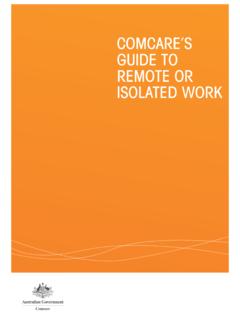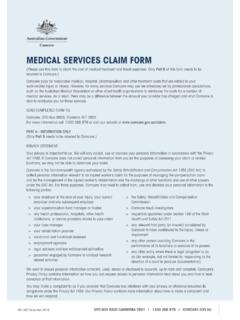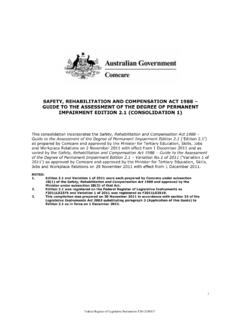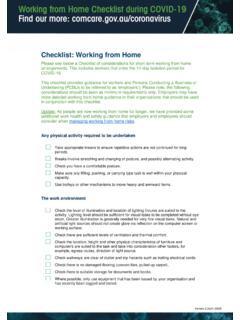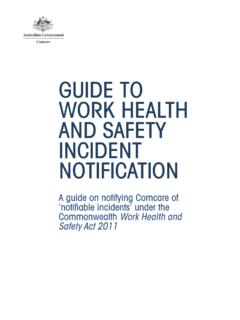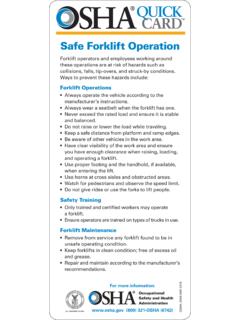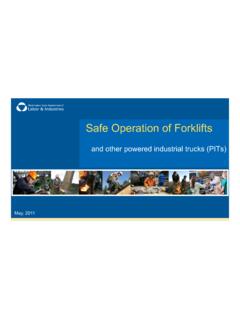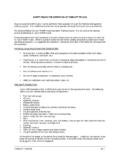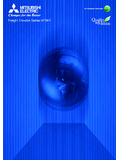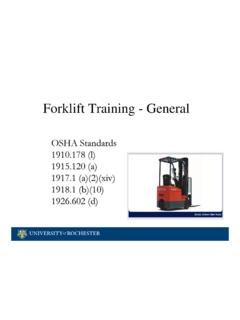Transcription of Forklift Safety, Reducing the Risks factsheet
1 Forklift . SAFETY. Reducing the Risks DISCLAIMER. This information is for guidance only and is not to be taken as an expression of the law. It should be read in conjunction with the relevant legislation. For more information contact your local workplace health and safety authority. PUBLICATION DETAILS. Published by Comcare Commonwealth of Australia 2012. All material presented in this publication is provided under a Creative Commons Attribution Australia ( ) licence. For the avoidance of doubt, this means this licence only applies to material as set out in this document. The details of the relevant licence conditions are available on the Creative Commons website (accessible using the links provided) as is the full legal code for the CC BY AU licence ( ). USE OF THE COAT OF ARMS. The terms under which the Coat of Arms can be used are detailed on the It's an Honour website ( ). CONTACT US. Inquiries regarding the licence and any use of this document are welcome at: Production Services Comcare GPO Box 9905.
2 Canberra ACT 2601. Ph: 1300 366 979. Email: 2. CONTENTS. INTRODUCTION 4. Forklift DANGERS 4. ABOUT THIS GUIDE 4. LEGAL RESPONSIBILITIES 5. PERSONS CONDUCTING A BUSINESS OR UNDERTAKING (PCBU): Reducing THE Risks 5. WORKERS: Reducing THE Risks 5. QUALIFICATIONS AND TRAINING 5. TRAINING 5. QUALIFICATIONS 6. WHAT PCBUS MUST DO 6. CONSULTATION 6. SELECTING A Forklift 7. MANUFACTURERS AND SUPPLIERS: Reducing THE Risks 8. PHYSICAL HAZARDS AND SAFETY ISSUES 8. INSTABILITY 8. SPEED AND STOPPING DISTANCES 10. SPRAINS AND STRAINS 12. SLIPS, TRIPS AND FALLS 12. ATTACHMENTS 13. OPERATION AND MAINTENANCE 14. CHECK THE Forklift BEFORE YOU START 14. CHECK THE WORKPLACE BEFORE YOU START 15. GET ON AND OFF SAFELY 15. OPERATE THE Forklift SAFELY 16. CARRYING AND HANDLING LOADS SAFELY 18. MAINTAIN THE Forklift 20. SUPPORTING SYSTEMS 21. TRAFFIC MANAGEMENT PLANS 21. POLICIES AND SAFE WORK PROCEDURES 24. INCIDENT REPORTING 24. ADDITIONAL INFORMATION 24. CONTACTS AND ACKNOWLEDGEMENTS 25. LOCAL WORKPLACE HEALTH AND SAFETY AUTHORITIES 25.
3 ACKNOWLEDGEMENTS 25. FURTHER INFORMATION 25. CONTACT DETAILS 25. 3. INTRODUCTION. forklifts or industrial lift trucks are used to lift, stack and transfer loads in warehouses, factories, shipping yards, freight terminals and other workplaces right across Australia. While forklifts offer a practical materials handling solution for many businesses, each year they continue to be associated with workplace deaths and injuries. The human and financial cost of Forklift -related incidents for workers, industry and the community is substantial. However, Forklift incidents can be prevented, especially when workers and persons conducting a business or undertaking (PCBU). work together to improve health and safety at work. This document seeks to improve health and safety outcomes in Australian workplaces by offering businesses and workers practical guidance on managing Risks related to forklifts . This guidance is not intended to cover all duty holders' responsibilities or hazards and Risks associated with industrial lift trucks.
4 Where container forklifts are used, such as in shipping yards and freight terminals, additional Risks exist that are not specifically covered in this document. Forklift DANGERS. As forklifts must be manoeuvrable they are designed to be compact. But when carrying loads they can become unstable under certain circumstances. Fully laden, a standard two tonne Forklift can weigh approximately five tonnes in total. With lower stability and greater manoeuvrability combined with uncontrolled traffic areas in workplaces you'll understand why forklifts are involved in so many incidents. Even at low speeds, forklifts can cause serious injuries and fatalities. It's not just the worker using the Forklift who can be injured pedestrians can be struck by a Forklift or its load. Don't wait until there is an injury or death at your workplace before developing a safe system of work to control Risks . ABOUT THIS GUIDE. Simple, safe practices can make a big difference. This includes observing speed limits and warning signs, wearing correctly fitted seat belts, slowing down and sounding the horn at an intersection.
5 Having a safe work environment effective worker training, well-maintained machinery, a traffic management plan, policies and procedures and effective supervision helps reduce the risk of Forklift -related injuries. This publication focuses on simple safety practices and involving everyone in the workplace to help reduce the risk of Forklift - related injuries. This guide has four sections, covering: > the responsibilities of PCBUs, workers and others > physical hazards and safety issues related to forklifts (for example, instability and body strain). > practical and safe ways to operate your Forklift (for example, carrying loads and maintaining the Forklift ). > supporting workplace systems (for example, traffic management plans and incident reporting). 4. LEGAL RESPONSIBILITIES. PERSONS CONDUCTING A BUSINESS OR UNDERTAKING (PCBU): Reducing THE Risks . You are responsible for providing: > a safe work environment > safe systems of work > safe and well-maintained machinery > proper information, training and supervision.
6 Combined with the principles of hazard management (see page 21) and an effective traffic management plan, these measures can help reduce the risk of Forklift -related injuries. This guide contains suggested checklists and practical information to help you do this. Choosing a safe Forklift is one of the most obvious ways to reduce the risk of a Forklift -related injury. If you are about to purchase or hire a Forklift , see Selecting a Forklift ' on page 7. WORKERS: Reducing THE Risks . You also have responsibilities to ensure a safe workplace by: > working with the PCBU and co-workers to improve safety > complying with reasonable instructions, training and information given, and following safe work procedures to do your work > not putting yourself or your co-workers at risk > reporting incidents, near misses and hazards (including unsafe equipment) to your PCBU or supervisor and health and safety representative > using protective equipment correctly. This guide contains suggested checklists and practical information to help you do this.
7 QUALIFICATIONS AND TRAINING. To operate a Forklift you must have a high risk work licence or be closely supervised while you are getting a high risk work licence. A high risk work licence requires you to be first trained by a Registered Training Organisation. Check with your local workplace safety authority (see page 25) for requirements in your state or territory. TRAINING. Training must be provided by a Registered Training Organisation and in the workplace under the competent supervision of a person with the same high risk work licence. Records of training (a logbook) must be maintained while you undertake your training. Registered Training Organisations provide logbooks to record training. Records should reflect the type of training undertaken to evidence both theory and practical training. The operator should be competent to operate a Forklift in the particular environment in which they are required to work. Specific skills require additional training. For example, before an operator starts using a Forklift or an attachment that is different to the one used for training and gaining qualifications further training and supervision is required.
8 5. QUALIFICATIONS. Independent accredited assessors will evaluate skills against a national instrument of assessment. Having a qualification indicates you have the basic knowledge and skills to operate a Forklift without danger to yourself or others. More specific skills are necessary for specialised Forklift types, attachments and worksite characteristics. A standard age limit applies wherever you operate a Forklift in Australia. A person wishing to be assessed for operation of a Forklift must be 18 years of age. Contact your local work health and safety authority for further information about the age requirement to operate a Forklift (see page 25). If you do not hold a qualification, you can only operate a Forklift under the direct supervision of an appropriately qualified Forklift operator or assessor who holds the relevant qualification. Direct supervision means that the qualified Forklift operator or assessor must be close enough that they can see what you are doing and provide appropriate verbal instruction.
9 When you operate and/or drive a Forklift on a public road, you must hold a current driver's licence and the Forklift must be registered. WHAT PCBUS MUST DO. A PCBU must: > provide site-specific and refresher training to maintain and enhance their workers' skills > ensure workers receive familiarisation training for any new Forklift (it may have different controls or varying attachments). > provide induction training for new or changed work environments, traffic management plans, policies and safe work procedures > maintain a register of licensed Forklift operators > ensure that all contractors and any other persons using a Forklift at your workplace hold the relevant Forklift licences. In addition, if your operators are required to use purpose-designed attachments and specific forklifts , you need to ensure that they have received sufficient instruction and training in a language that they understand. Ensure training manuals and manufacturer's information is available to your workers.
10 CONSULTATION. To achieve a safe and healthy workplace, PCBUs, workers, managers, contractors and visitors must communicate with each other and work together. PCBUs can facilitate the consultation process by talking to the workers who use forklifts , as they have first-hand knowledge of any associated safety issues at the workplace. PCBUs need to involve health and safety representatives and health and safety committees in this process. By tapping into their knowledge, solutions are more likely to be practical, accepted and adopted. In turn, your worksite is more likely to reduce Forklift -related injuries. 6. A PCBU should consult: > when identifying the specific hazards and assessing the Risks associated with the forklifts in their workplace > when developing a traffic management plan > before implementing any action to control the Risks > before making any change to the worksite > before buying or hiring any equipment > once solutions have been implemented to ensure they are effective and practical.

